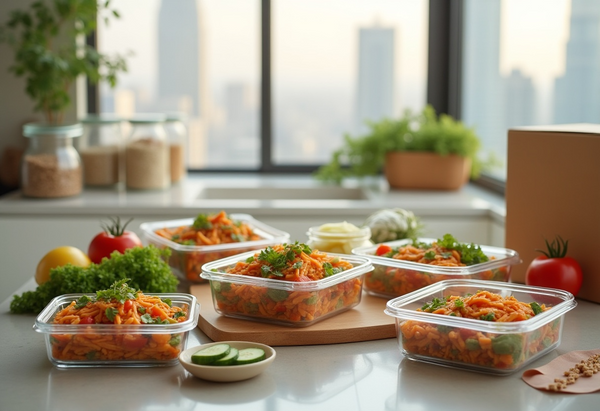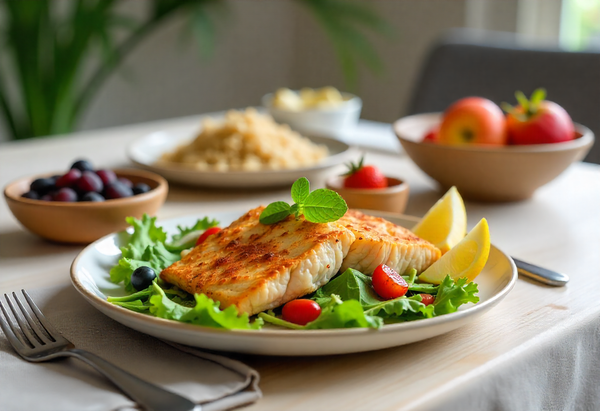Sustainability in Meal Prep: Reducing Food and Packaging Waste at Home
by JUSTINE YOLANDA

In a world where food waste accounts for nearly a third of all food produced and single-use packaging continues to choke landfills, the way we prepare our meals matters more than ever. Here in Dubai, the stakes are even higher with a fast-paced lifestyle, heavy reliance on imports and growing environmental awareness, the shift toward sustainable meal prep is no longer a niche trend, it’s a necessity. Every container you choose, every portion you plan and every ingredient you source can reduce your personal environmental footprint while saving you money.
In this guide, we’ll break down exactly what sustainable meal prep means in practice, from smarter shopping and storage tips to reducing single-use plastics and making the most of every ingredient. You’ll also see how Basiligo is walking the talk with eco-conscious sourcing, recyclable packaging and waste reduction KPIs that set us apart in the UAE market.
What Is Sustainable Meal Prep?
Sustainable meal prep is more than just cooking in bulk; it's about making conscious choices at every stage of the process to reduce environmental impact. It combines smart planning, mindful sourcing and eco-friendly storage practices to minimise both food waste and packaging waste.
At its core, sustainable meal prep focuses on:
-
Using seasonal and local produce to cut down on transport emissions.
-
Portion control to prevent uneaten food from ending up in the bin.
-
Choosing reusable or compostable packaging over single-use plastics.
-
Maximising ingredient use, from root-to-stem cooking to creative leftover recipes.
The benefits extend far beyond your kitchen. Reducing waste lowers methane emissions from landfills and swapping out plastic for biodegradable or reusable materials reduces the demand for fossil-fuel-based packaging. On a household level, it also saves money; fewer wasted groceries means more value from every dirham spent.
From a carbon perspective, every avoided kilogram of food waste prevents around 2.5 kg of greenhouse gas emissions. Multiply that over weeks and months and your kitchen habits start to have a measurable impact. The same applies to packaging: cutting down on single-use containers can reduce your household’s annual plastic footprint by several kilograms.
In short, sustainable meal prep is about aligning what you eat with how you want to impact the planet, proving that convenience and environmental responsibility can go hand in hand.
Smart Shopping & Portion Planning: Reduce Food Waste
The foundation of sustainable meal prep starts at the grocery store. Smart shopping means buying only what you need, focusing on quality over quantity and embracing imperfect or “ugly” produce that misshapen carrots or bruised apples that are just as nutritious but often discarded by retailers. Choosing these helps reduce food waste upstream and supports more sustainable farming practices.
Meal planning is your best weapon against waste. Before shopping, map out meals for the week, factoring in portion sizes based on your household’s appetite. Overestimating portions often leads to leftovers that get forgotten or tossed. Instead, plan batch sizes that match your consumption patterns, whether cooking for one or a family.
Leftovers don’t have to be a problem, think of them as opportunities. Repurpose dinner into next-day lunches or transform ingredients into new dishes, like turning roasted veggies into a hearty soup or stir-fry. Label and date your prepped meals to keep track and avoid spoilage.
Proper storage plays a crucial role in prolonging freshness. Use airtight containers, invest in reusable silicone bags and learn which fruits and vegetables last longer in the fridge or at room temperature. For example, store herbs in water like fresh flowers and keep potatoes in a cool, dark place rather than the fridge.
By combining thoughtful shopping, precise portioning and smart storage, you not only reduce food waste but also make your meal prep more efficient and economical. This approach supports a healthier planet and a happier kitchen, with fewer trips to the bin and more enjoyment of every bite.
Packaging Choices & Home Replacements
When it comes to sustainable meal prep, what you put your food in is just as important as what you put in your meals. Single-use plastics, cling film and disposable containers contribute massively to landfill waste and environmental pollution especially in fast-paced cities like Dubai, where convenience often trumps eco-consciousness. But there are practical, affordable alternatives that fit seamlessly into your routine.
Reusable containers made from glass, stainless steel, or BPA-free plastics are great investments. They’re durable, easy to clean and reduce the need for constantly buying disposable packaging. Pair these with beeswax wraps or silicone lids to replace cling film both are breathable, washable and keep food fresh without plastic.
Buying in bulk is another smart move. Look for local markets or stores that offer unpackaged grains, nuts and dried fruits and bring your own containers. Not only does this reduce packaging waste, but bulk buying can also save money and ensure you have pantry staples on hand for meal prep.
In Dubai, there’s a growing selection of eco-friendly packaging alternatives sourced locally or regionally, such as compostable trays or biodegradable bags made from plant-based materials. Supporting these options helps build a sustainable supply chain while reducing your carbon footprint.
However, be cautious of greenwashing marketing that overstates or misleads about a product’s eco-credentials. Terms like “natural,” “eco-friendly,” or “biodegradable” aren’t always regulated. Always check for third-party certifications or clear disposal instructions before committing.
Price alert: While sustainable packaging might seem pricier upfront, it pays off long-term through durability and waste reduction. Plus, as demand grows, more affordable options are hitting the market, making it easier than ever to choose green without breaking the bank.
Simple Meal-Prep Recipes That Minimise Waste
Minimising waste doesn’t mean sacrificing flavor or variety. These three quick meal-prep recipes use whole ingredients and leftovers creatively, helping you enjoy tasty meal plans while reducing food scraps.
1. Veggie Stir-Fry with Brown Rice
Use leftover cooked rice and any vegetables nearing their expiration—carrots, bell peppers, broccoli stems. Toss them in a hot pan with garlic, soy sauce and a splash of sesame oil. Add tofu or chickpeas for protein. This one-pan dish comes together in 15 minutes and transforms odds and ends into a nutritious meal.
2. Root-to-Stem Soup
Save vegetable peels and ends (like carrot tops, onion skins, celery leaves) throughout the week in the freezer. Blend them into a flavorful broth base with potatoes, tomatoes and any leafy greens. This warming soup uses every part of your veggies and freezes well for easy reheating.
3. Frittata with Leftover Greens & Cheese
Whisk eggs and pour over sautéed leftover greens such as spinach or kale. Add in diced cooked potatoes or grains and top with a sprinkle of cheese or nutritional yeast. Bake until set for a protein-packed dish perfect for breakfast, lunch, or dinner.
These recipes prove that sustainable meal prep is about creativity and resourcefulness. By repurposing leftovers and using whole ingredients, you reduce waste and keep your meals fresh and exciting.
Basiligo’s Approach: How We Minimise Waste
At Basiligo, sustainability is woven into every step of our meal prep process, from sourcing ingredients to delivering your meals. We partner with trusted suppliers like Albustan Packing, known for their commitment to eco-friendly materials and responsible manufacturing. Our packaging is carefully selected to be 85% recyclable, using compostable trays, biodegradable films and reusable containers whenever possible.
We set ambitious reduction targets to continuously improve our environmental impact. Our current goals include a 30% reduction in packaging waste by the end of 2025 and a 25% cut in food waste across our supply chain. To achieve this, we work closely with our suppliers on precise order forecasting and ingredient optimization.
Food that doesn’t make it into your meal is never wasted. We collaborate with local donation partners to redistribute safe, surplus food to community centers and charities across Dubai, supporting those in need and reducing landfill contributions.
Our delivery strategy is another pillar of our waste minimization efforts. By consolidating deliveries and optimizing routes, we reduce carbon emissions and packaging usage. This not only benefits the planet but also ensures your meals arrive fresh and on time.
How to Audit a Meal-Prep Service’s Sustainability Claims
Not all sustainability claims are created equal. To make sure your meal-prep service walks the talk, use this quick checklist:
-
Certifications: Look for third-party eco-labels like ISO 14001, FSC packaging, or halal sustainability certifications.
-
Packaging codes: Check if packaging materials are recyclable or compostable (look for recycling symbols or clear disposal instructions).
-
Supplier transparency: Does the company share their supplier list or sourcing policies? This shows accountability.
-
Life Cycle Assessment (LCA): Some services provide LCA data showing environmental impact from farm to delivery—this is a gold standard for transparency.
Conclusion
Ready to make your meal prep truly sustainable? Try Basiligo’s Sustainable Starter Pack today and experience eco-friendly meals designed to minimize waste and maximize taste.
FAQ
What is sustainable meal prep?
Sustainable meal prep involves planning, cooking and storing meals in ways that minimize food waste and reduce environmental impact, such as using reusable containers and buying local ingredients.
How can I reduce food waste when meal prepping?
Plan portions carefully, use leftovers creatively, store food properly and shop for “ugly” produce to cut down on wasted ingredients.
Are reusable containers better than disposable ones?
Yes. Reusable containers reduce plastic waste, are often more durable and can save money over time compared to single-use packaging.
How do I spot greenwashing in meal prep packaging?
Watch for vague claims like “eco-friendly” without certifications or clear disposal instructions. Look for third-party labels like FSC or compostability certifications.
Does Basiligo provide transparency on its sustainability efforts?
Absolutely. Basiligo shares supplier details, packaging specs, waste reduction targets and partners with donation programs to ensure real impact.
Can sustainable meal prep save me money?
Yes. By reducing food waste and investing in durable packaging, you get more value from your groceries and lower your overall meal prep costs.




